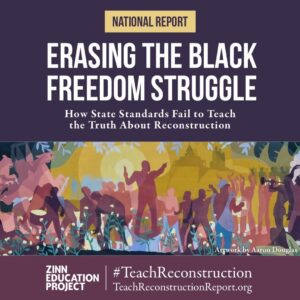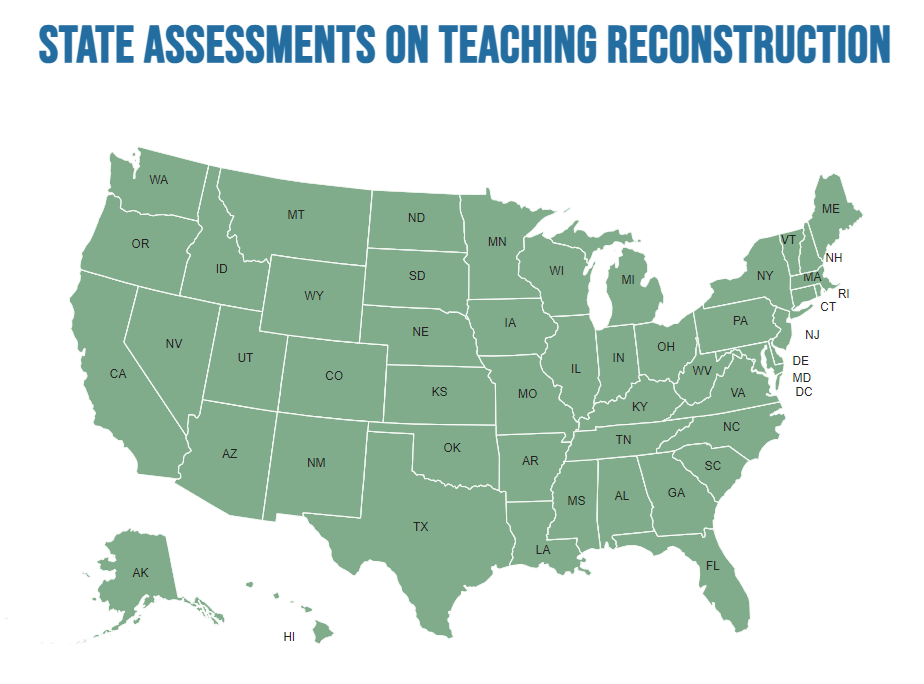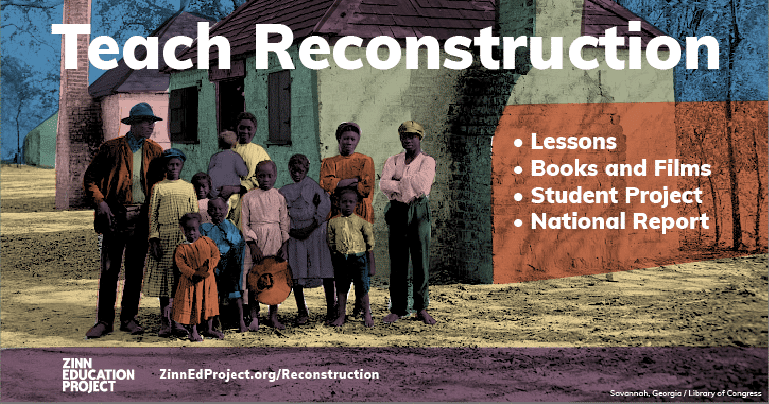The national report Erasing the Black Freedom Struggle grew out of the Zinn Education Project’s campaign to teach Reconstruction — one of the most consequential, instructive, misunderstood, and suppressed eras of U.S. history.
 This study makes a comprehensive effort to examine the nature and extent of the barriers to teaching Reconstruction effectively. It looks to state social studies standards and local curricula as one piece of why Reconstruction is so poorly understood, assesses standards and curricula using the Zinn Education Project’s standards of what a complex and truthful history of the era should include, and offers key findings and recommendations for improvement. This report is the first national study of standards on Reconstruction and has entered into larger conversations over how we teach, understand, and use history.
This study makes a comprehensive effort to examine the nature and extent of the barriers to teaching Reconstruction effectively. It looks to state social studies standards and local curricula as one piece of why Reconstruction is so poorly understood, assesses standards and curricula using the Zinn Education Project’s standards of what a complex and truthful history of the era should include, and offers key findings and recommendations for improvement. This report is the first national study of standards on Reconstruction and has entered into larger conversations over how we teach, understand, and use history.
As you delve into the report, we encourage you to explore and discuss its implications for your classrooms and curricula. Each heading below links to a specific piece of the report. Consider the questions and activities underneath to help guide your study.
First, reflect on your own experiences as a student.
- What do you recall learning about Reconstruction during your K–12 education, if anything? What words or feelings did you associate with the Reconstruction era?
Activity: As you reflect, write down key words or phrases that come to mind. Then assign one person in your group to enter everyone’s responses into WordItOut and generate a word cloud. Have that person share the word cloud with the whole group — screen share on Zoom if meeting virtually, or gather around one computer or phone screen if meeting in person. Discuss what came up for each of you, and collectively.
- What surprises you about these word cloud responses? What patterns or connections do you see? What questions do you have as you begin your new study?
The report begins with a quote from the National Park Service, which describes Reconstruction as “one of the most complicated, poorly understood, and significant periods of American history.”
- As you read through the sections titled “Reconstruction Defined,” “Why Is It Poorly Understood?,” and “The Relevance of Reconstruction,” what evidence do you see to support that quote?
- What arguments and examples resonate most with you?
Read Introduction.
- In what ways does the Zinn Education Project’s position on social studies standards reflect or challenge your own?
- How do standards connect to your curriculum, your district’s ethos on teaching, and broader conversations in the United States over our shared history?
Read What We Believe About Standards.
Activity: Using Zoom Whiteboard if meeting virtually or sticky notes/flip charts if meeting in person, list each recommended standard on different notes/papers that your whole group can see and write on. Then read the recommended standards and individually record your thoughts on each one.
- Prompts to consider:
- What areas of the standards do you feel your teaching is strong in, and what areas would you like to improve on?
- What are you most inspired to focus on this year?
- What resources or plans might you have for channeling that inspiration into your teaching?
Reconvene as a full group and discuss what came up. Is there any overlap between your individual responses that might act as a bridge to further collaboration?
Alternative activity: Split into pairs and review the recommended standards together. Use the prompts above as guiding questions, then reconvene as a full group and share out.
Read Standards Rubric.
Activity: Using Zoom Whiteboard if meeting virtually or sticky notes/flip charts if meeting in person, list each key finding on different notes/papers that your whole group can see and write on. Then read the findings and individually record your thoughts on each one.
- Prompts to consider:
- What do you find interesting, surprising, or troubling about these findings?
- How do the findings align with your own experience?
- Which ring most true for your district? Which ring most true for your practice?
- What are the implications of these findings?
Reconvene as a full group and discuss what came up.
Alternative activity: Split into pairs and review the findings together. Use the prompts above as guiding questions, then reconvene as a full group and share out.
Read Key Findings.
- What do you find exciting, challenging, or hopeful about these recommendations on content, pedagogy, and professional development?
- So often districts tell teachers what to do — what should yours do better to support you in teaching about Reconstruction?
Activity: In small groups or all together, write your own recommendations for your district. Consider also trying this activity with your students at the end of your Reconstruction unit.
Read Recommendations.
Take a look at your state’s assessment page, which features a local vignette from Reconstruction history, an overview of standards, educator experiences, and an assessment that includes a summary of the state’s recent anti-history education measures (if applicable).
- What reactions come up as you review each section of the assessment page? Where do you see your own experiences in education reflected or challenged?
- Which key findings show up in your state’s assessment?
- How could applying the Zinn Education Project’s standards rubric and recommendations improve your state’s assessment?
Read State Assessments.
The report features a collection of stories — teachable vignettes, with primary and secondary sources — from all 50 states and the District of Columbia.
An addendum to the report, the article “Five Ways Textbooks Lie About Reconstruction” analyzes the most commonly used U.S. history textbooks.
- What do you find interesting, surprising, or troubling about these five lies?
- How do the examples featured in the article align with your classroom textbook?
- How might you and your students “read against the grain” of your classroom textbook?
Read Textbook Critique.
 This study makes a comprehensive effort to examine the nature and extent of the barriers to teaching Reconstruction effectively. It looks to state social studies standards and local curricula as one piece of why Reconstruction is so poorly understood, assesses standards and curricula using the Zinn Education Project’s standards of what a complex and truthful history of the era should include, and offers key findings and recommendations for improvement. This report is the first national study of standards on Reconstruction and has entered into larger conversations over how we teach, understand, and use history.
This study makes a comprehensive effort to examine the nature and extent of the barriers to teaching Reconstruction effectively. It looks to state social studies standards and local curricula as one piece of why Reconstruction is so poorly understood, assesses standards and curricula using the Zinn Education Project’s standards of what a complex and truthful history of the era should include, and offers key findings and recommendations for improvement. This report is the first national study of standards on Reconstruction and has entered into larger conversations over how we teach, understand, and use history.


